Flexure Performance of Textile-Reinforced Cementitious Composites with Novel Inclined Reinforcements
Abstract
:1. Introduction
1.1. Background and Motivation
1.2. Outline
2. Methodology
2.1. Preparation and Testing
2.2. Model Development
3. Results and Discussion
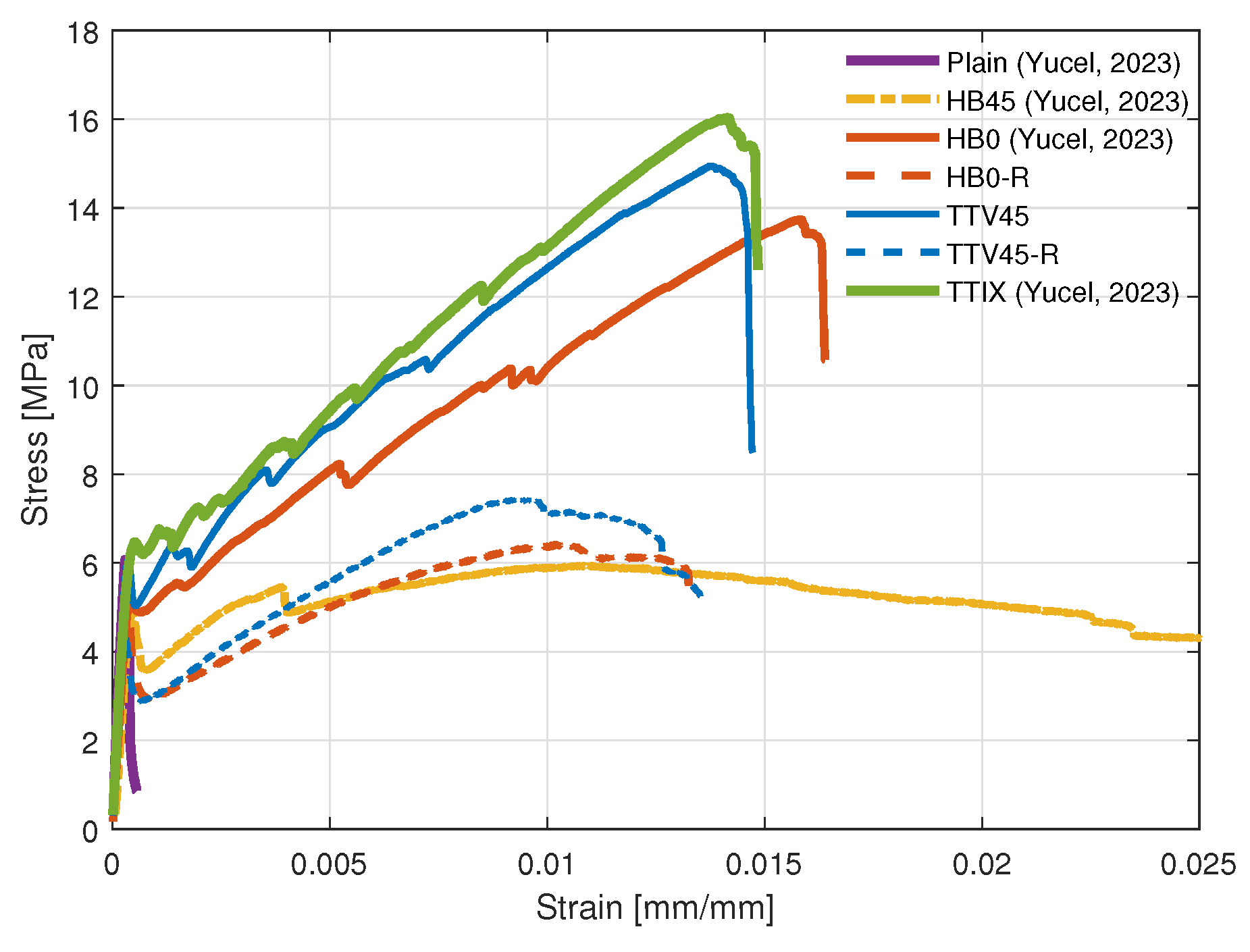
4. Conclusions
Author Contributions
Funding
Institutional Review Board Statement
Informed Consent Statement
Data Availability Statement
Acknowledgments
Conflicts of Interest
References
- Peled, A.; Bentur, A.; Mobasher, B. Textile Reinforced Concrete; CRC Press: London, UK, 2017. [Google Scholar]
- Fangueiro, R. Fibrous and Composite Materials for Civil Engineering Applications; Elsevier: Cambridge, UK, 2011. [Google Scholar]
- Rawat, P.; Liu, S.; Guo, S.; Rahman, M.Z.; Yang, T.; Bai, X.; Yao, Y.; Mobasher, B.; Zhu, D. A state-of-the-art review on mechanical performance characterization and modelling of high-performance textile reinforced concretes. Constr. Build. Mater. 2022, 347, 128521. [Google Scholar] [CrossRef]
- Kim, H.Y.; You, Y.J.; Ryu, G.S.; Koh, K.T.; Ahn, G.H.; Kang, S.H. Flexural strengthening of concrete slab-type elements with textile reinforced concrete. Materials 2020, 13, 2246. [Google Scholar] [CrossRef] [PubMed]
- Hegger, J.; Voss, S. Investigations on the bearing behaviour and application potential of textile reinforced concrete. Eng. Struct. 2008, 30, 2050–2056. [Google Scholar] [CrossRef]
- Herbrand, M.; Adam, V.; Classen, M.; Kueres, D.; Hegger, J. Strengthening of existing bridge structures for shear and bending with carbon textile-reinforced mortar. Materials 2017, 10, 1099. [Google Scholar] [CrossRef]
- Reinhardt, H.W.; Krüger, M.; Raupach, M.; Orlowsky, J. Behavior of textile-reinforced concrete in fire. Spec. Publ. 2008, 250, 99–110. [Google Scholar]
- Brückner, A.; Ortlepp, R.; Curbach, M. Textile reinforced concrete for strengthening in bending and shear. Mater. Struct. 2006, 39, 741–748. [Google Scholar] [CrossRef]
- Friese, D.; Scheurer, M.; Hahn, L.; Gries, T.; Cherif, C. Textile reinforcement structures for concrete construction applications—A review. J. Compos. Mater. 2022, 56, 4041–4064. [Google Scholar] [CrossRef]
- Carozzi, F.G.; Milani, G.; Poggi, C. Mechanical properties and numerical modeling of Fabric Reinforced Cementitious Matrix (FRCM) systems for strengthening of masonry structures. Compos. Struct. 2014, 107, 711–725. [Google Scholar] [CrossRef]
- Giese, A.C.H.; Giese, D.N.; Dutra, V.F.P.; Da Silva Filho, L.C.P. Flexural behavior of reinforced concrete beams strengthened with textile reinforced mortar. J. Build. Eng. 2021, 33, 101873. [Google Scholar] [CrossRef]
- Djamai, Z.I.; Erroussafi, K.; Si Larbi, A.; Salvatore, F.; Cai, G. Analytical modeling of textile reinforced concrete (TRC) sandwich panels: Consideration of nonlinear behavior and failure modes. Mech. Adv. Mater. Struct. 2022, 29, 33–52. [Google Scholar] [CrossRef]
- Hojdys, Ł.; Krajewski, P. Tensile behaviour of FRCM composites for strengthening of masonry structures—An experimental investigation. Materials 2021, 14, 3626. [Google Scholar] [CrossRef] [PubMed]
- Rossi, E.; Randl, N.; Mészöly, T.; Harsányi, P. Effect of TRC and F/TRC Strengthening on the Cracking Behaviour of RC Beams in Bending. Materials 2021, 14, 4863. [Google Scholar] [CrossRef]
- Deng, L.; Lei, L.; Lai, S.; Liao, L.; Zhou, Z. Experimental study on the axial tensile properties of FRP grid-reinforced ECC composites. Materials 2021, 14, 3936. [Google Scholar] [CrossRef] [PubMed]
- Holler, S.; Butenweg, C.; Noh, S.Y.; Meskouris, K. Computational model of textile-reinforced concrete structures. Comput. Struct. 2004, 82, 1971–1979. [Google Scholar] [CrossRef]
- Sciegaj, A.; Almfeldt, S.; Larsson, F.; Lundgren, K. Textile reinforced concrete members subjected to tension, bending, and in-plane loads: Experimental study and numerical analyses. Constr. Build. Mater. 2023, 408, 133762. [Google Scholar] [CrossRef]
- Williams Portal, N.; Nyholm Thrane, L.; Lundgren, K. Flexural behaviour of textile reinforced concrete composites: Experimental and numerical evaluation. Mater. Struct. 2017, 50, 1–14. [Google Scholar] [CrossRef]
- Deng, Z.; Xu, J. Uniaxial tensile behavior of engineering cementitious composite reinforced with fiber textile grid and steel wire mesh. Mech. Adv. Mater. Struct. 2024, 1–15. [Google Scholar] [CrossRef]
- Schladitz, F.; Frenzel, M.; Ehlig, D.; Curbach, M. Bending load capacity of reinforced concrete slabs strengthened with textile reinforced concrete. Eng. Struct. 2012, 40, 317–326. [Google Scholar] [CrossRef]
- Hegger, J.; Will, N.; Bruckermann, O.; Voss, S. Load–bearing behaviour and simulation of textile reinforced concrete. Mater. Struct. 2006, 39, 765–776. [Google Scholar] [CrossRef]
- Halvaei, M.; Jamshidi, M.; Latifi, M.; Ejtemaei, M. Experimental investigation and modelling of flexural properties of carbon textile reinforced concrete. Constr. Build. Mater. 2020, 262, 120877. [Google Scholar] [CrossRef]
- Banholzer, B.; Brockmann, T.; Brameshuber, W. Material and bonding characteristics for dimensioning and modelling of textile reinforced concrete (TRC) elements. Mater. Struct. 2006, 39, 749–763. [Google Scholar] [CrossRef]
- Sciegaj, A.; Larsson, F.; Lundgren, K. Experiments and calibration of a bond-slip relation and efficiency factors for textile reinforcement in concrete. Cem. Concr. Compos. 2022, 134, 104756. [Google Scholar] [CrossRef]
- Yücel, C.G.; Öztürk, O.; Aydoğan, O.; Akın, S.; Özyurt, N.; Kocaman, E.S. Smart Material Design of Textile-Reinforced Composites for Thin-Section Structures. In Proceedings of the International Symposium of the International Federation for Structural Concrete, Istanbul, Turkey, 5–7 June 2023; Springer: Cham, Switzerland, 2023; pp. 898–906. [Google Scholar]
- Bertolesi, E.; Carozzi, F.G.; Milani, G.; Poggi, C. Numerical modeling of Fabric Reinforce Cementitious Matrix composites (FRCM) in tension. Constr. Build. Mater. 2014, 70, 531–548. [Google Scholar] [CrossRef]
- Mazzuca, P.; Pisani, B.; Firmo, J.P.; Ombres, L. Tensile and bond properties at elevated temperatures of a PBO-FRCM composite system for strengthening concrete elements: Experimental and analytical investigations. Constr. Build. Mater. 2024, 432, 136519. [Google Scholar] [CrossRef]
- TS EN 197-1; Çimento-Bölüm 1: Genel Çimentolar-Bileşim, Özellikler ve Uygunluk Kriterleri. TSE: Ankara, Türkiye, 2002; Volume 3.
- ASTM C230/C230M-14; Standard Specification for Flow Table for Use in Tests of Hydraulic Cement. ASTM: West Conshohocken, PA, USA, 2014; Volume 1.
- Yu, J.; Chen, Y.; Leung, C.K. Mechanical performance of Strain-Hardening Cementitious Composites (SHCC) with hybrid polyvinyl alcohol and steel fibers. Compos. Struct. 2019, 226, 111198. [Google Scholar] [CrossRef]
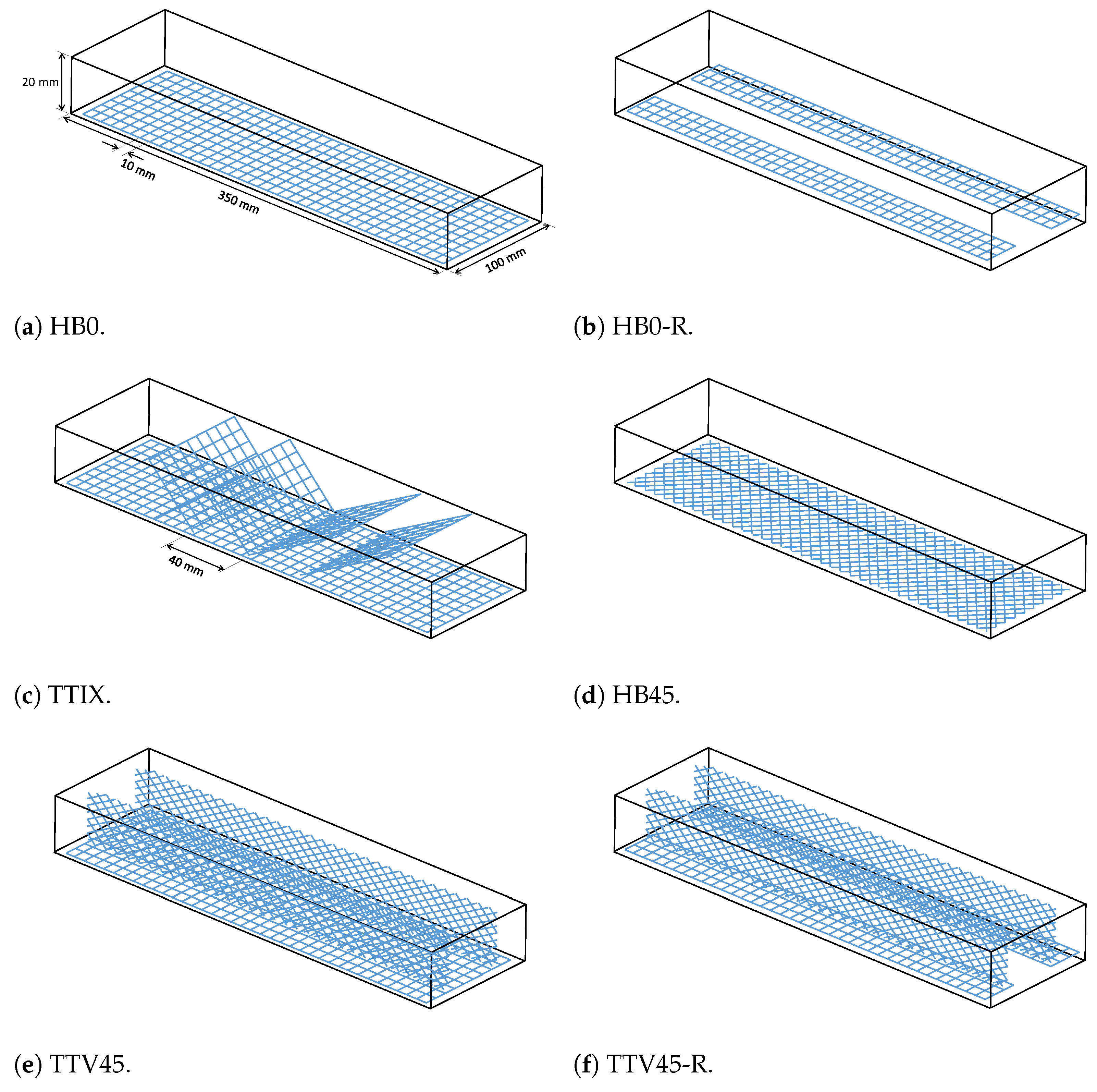
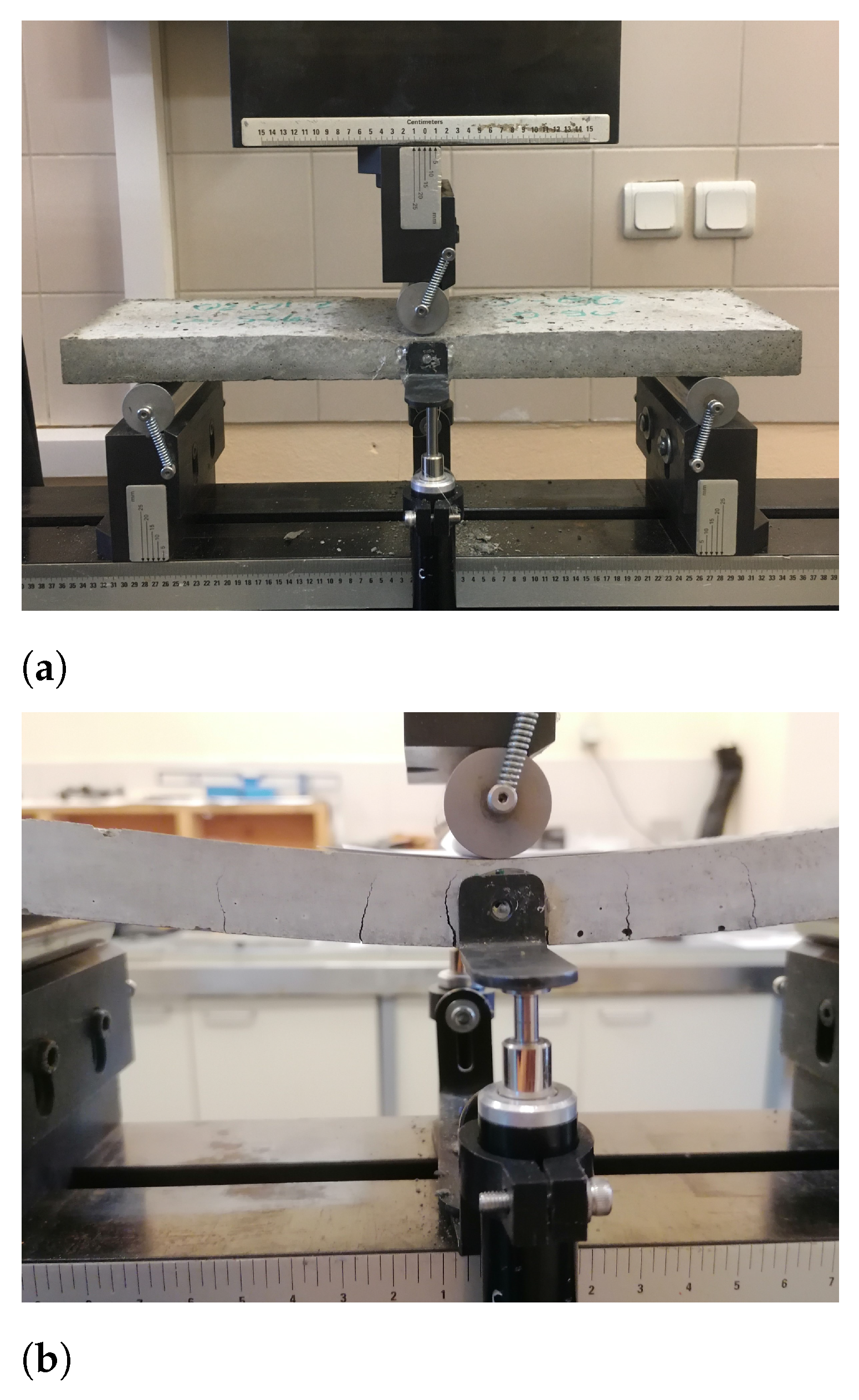

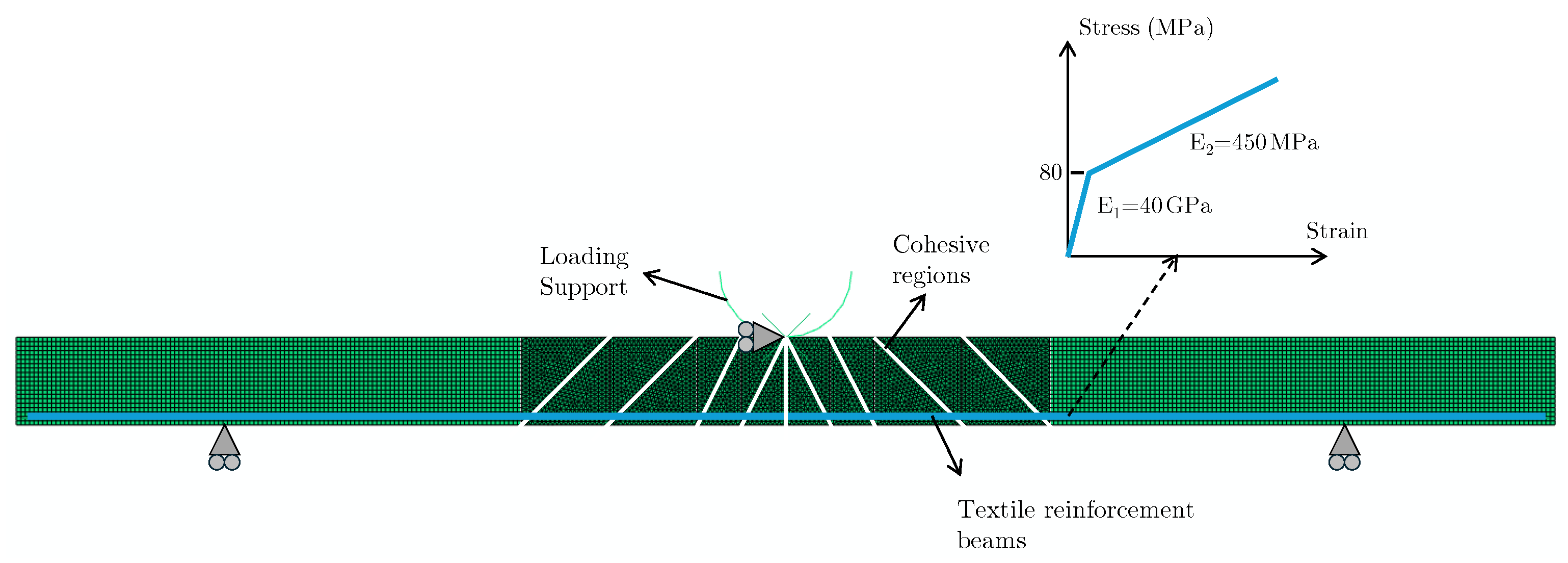
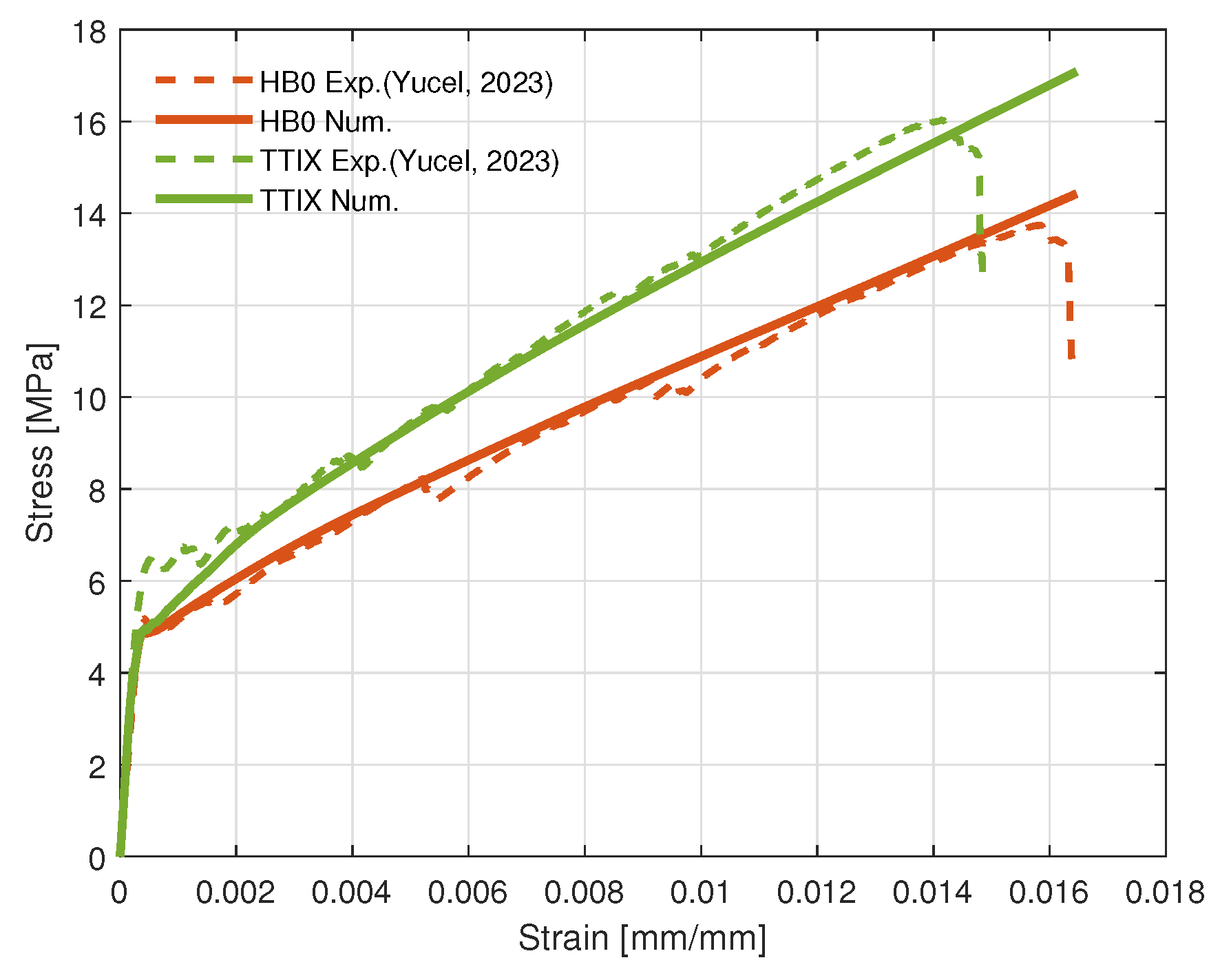
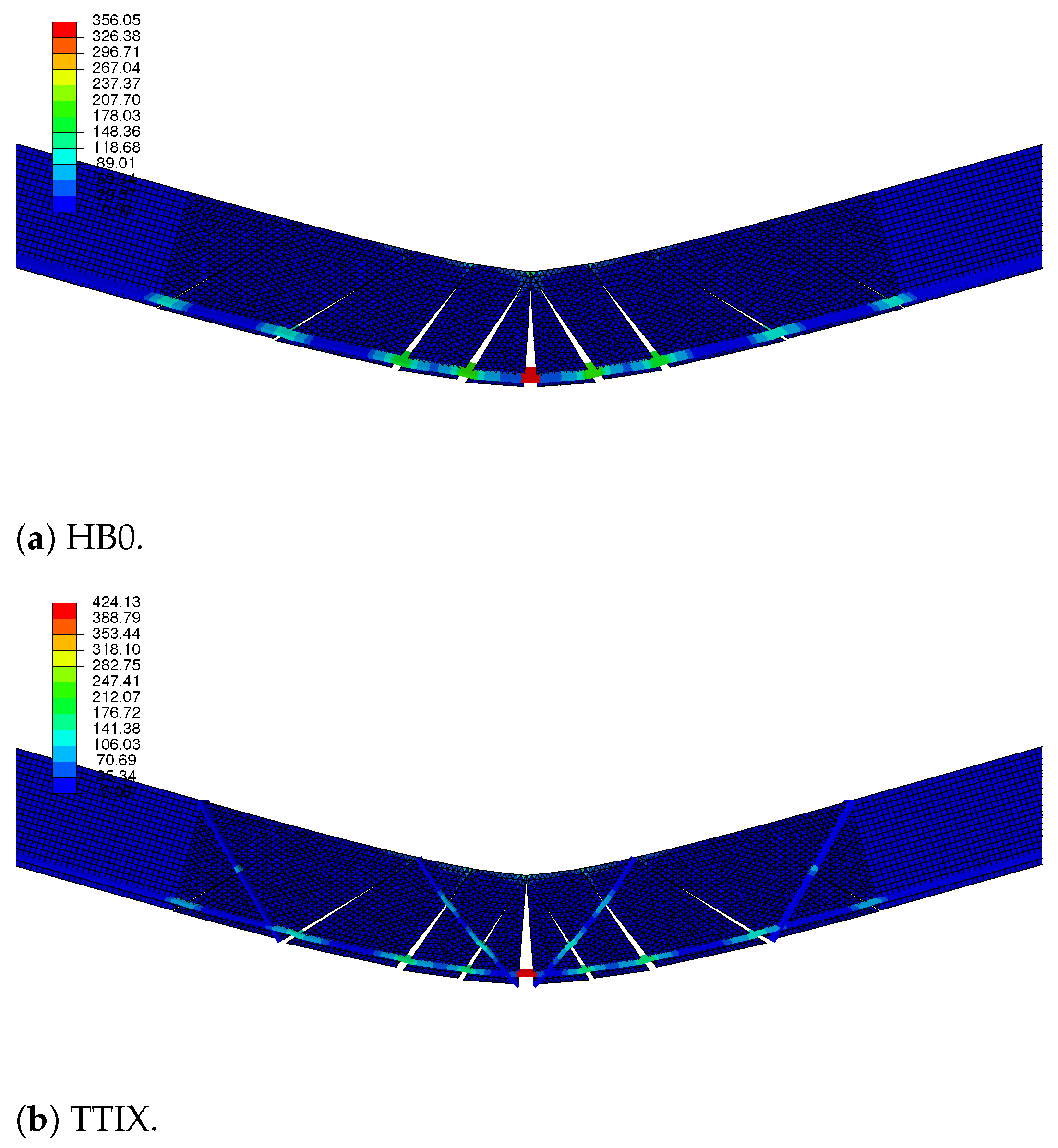
| Property | Values |
|---|---|
| Reinforcement Yield strength | 80 MPa |
| Reinforcement Hardening Modulus | 450 MPa |
| Cohesive Fracture Strength | 0.5 MPa |
| Cohesive Fracture Energy | 0.075 |
| Configuration | Ultimate Stress (MPa) | Hardening Modulus (MPa) | Reinforcement Weight (g) | R-Squared Values |
|---|---|---|---|---|
| Plain | 6.07 | - | - | - |
| HB0 | 13.73 | 577 | 11.25 | 0.996 |
| TTV45 | 14.94 | 733 | 15.95 | 0.995 |
| TTIX | 16.02 | 754 | 14.97 | 0.999 |
| HB0-R | 6.40 | 383 | 7.7 | 0.971 |
| TTV45-R | 7.43 | 553 | 12.4 | 0.999 |
Disclaimer/Publisher’s Note: The statements, opinions and data contained in all publications are solely those of the individual author(s) and contributor(s) and not of MDPI and/or the editor(s). MDPI and/or the editor(s) disclaim responsibility for any injury to people or property resulting from any ideas, methods, instructions or products referred to in the content. |
© 2024 by the authors. Licensee MDPI, Basel, Switzerland. This article is an open access article distributed under the terms and conditions of the Creative Commons Attribution (CC BY) license (https://creativecommons.org/licenses/by/4.0/).
Share and Cite
Kocaman, E.S.; Henzel, T.; Aydogan, O.G.; Yucel, C.G. Flexure Performance of Textile-Reinforced Cementitious Composites with Novel Inclined Reinforcements. Materials 2024, 17, 4743. https://doi.org/10.3390/ma17194743
Kocaman ES, Henzel T, Aydogan OG, Yucel CG. Flexure Performance of Textile-Reinforced Cementitious Composites with Novel Inclined Reinforcements. Materials. 2024; 17(19):4743. https://doi.org/10.3390/ma17194743
Chicago/Turabian StyleKocaman, Esat Selim, Thomas Henzel, Olcay Gurabi Aydogan, and Can Gurer Yucel. 2024. "Flexure Performance of Textile-Reinforced Cementitious Composites with Novel Inclined Reinforcements" Materials 17, no. 19: 4743. https://doi.org/10.3390/ma17194743







